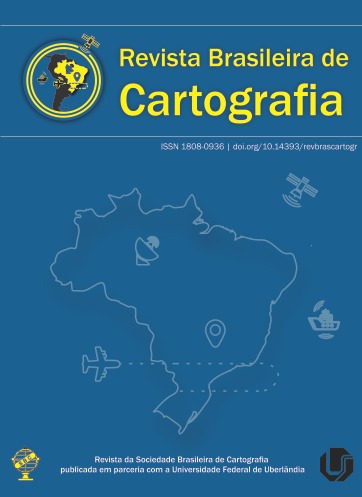Símbolos Pontuais para o Mapeamento Topográfico em Escala Grande
Conteúdo do artigo principal
Resumo
Existe a falta de uma simbologia pontual padronizada para ser aplicada ao mapeamento topográfico em escala grande no Brasil. Ademais, há a necessidade da discussão de conceitos da percepção visual para o desenvolvimento dos símbolos cartográficos. Nesse sentido, este trabalho propõe símbolos pontuais para mapas em escala grande (1:2.000). Essa abordagem é construída com base nos conceitos de percepção visual para a proposição dos símbolos e em testes de preferência dos usuários por esses símbolos para o mapeamento topográfico em escala grande. O teste de preferência foi aplicado após tarefas de leitura de mapas envolvendo os níveis de navegação e mensuração propostos por Board (1978). Um total de 121 participantes realizou o teste em ambiente digital. O teste visou avaliar se símbolos com contorno e com fundo branco são mais bem detectados, discriminados e reconhecidos no contexto do mapa. Os símbolos que não foram considerados eficazes de acordo com esta metodologia proposta por Clarke (1989) foram reformulados, a fim de que possíveis falhas no processo da criação dos símbolos fossem corrigidas. Os símbolos testados e não testados foram disponibilizados para a comunidade acadêmica através da plataforma Github do Laboratório Geoespacial Livre da Universidade Federal do Paraná, para que possam ser utilizados e aprimorados por pesquisadores e usuários da área.
Downloads
Métricas
Detalhes do artigo
Autores que publicam nesta revista concordam com os seguintes termos:
- Autores mantém os direitos autorais e concedem à revista o direito de primeira publicação, com o trabalho simultaneamente licenciado sob a Licença Creative Commons Atribuição que permite o compartilhamento do trabalho com reconhecimento da autoria e publicação inicial nesta revista.
- Autores têm autorização para assumir contratos adicionais separadamente, para distribuição não-exclusiva da versão do trabalho publicada nesta revista (ex.: publicar em repositório institucional ou como capítulo de livro), com reconhecimento de autoria e publicação inicial nesta revista.
- Autores têm permissão e são estimulados a publicar e distribuir seu trabalho online (ex.: em repositórios institucionais ou na sua página pessoal) a qualquer ponto antes ou durante o processo editorial, já que isso pode gerar alterações produtivas, bem como aumentar o impacto e a citação do trabalho publicado (veja "O Efeito do Acesso Aberto").





